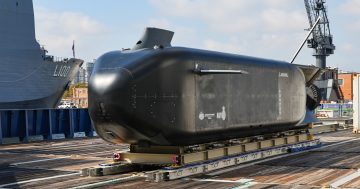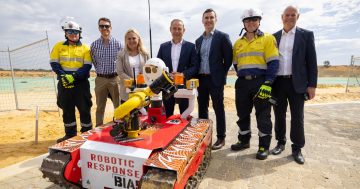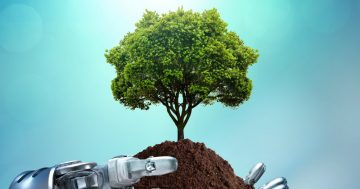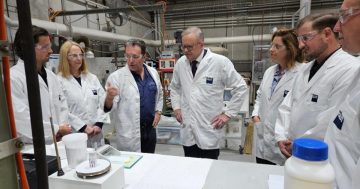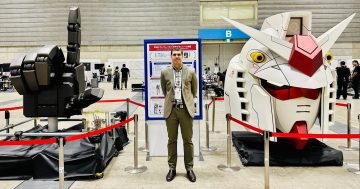Robert Ravensbergen* discusses how robots can actually help support a poorer larger, and older global population.
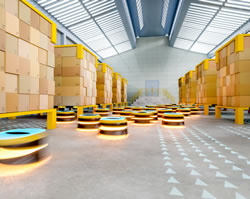 There has been in some ways a persistent sense of global crisis that long predates the advent of COVID-19.
There has been in some ways a persistent sense of global crisis that long predates the advent of COVID-19.
Growing inequality both within and between countries has been tied to new power competitions on the international stage, along with an increased competition for basic natural resources.
Differing natural resources, financial resources, and standards of living between countries have further exacerbated the regional and global rivalries that have emerged since the end of the Cold War.
In that time, financial capitalism has effectively served as the world’s de facto “operating system.”
However, as record stimulus and new commitments to growth emerge following the fight against COVID-19, the laws of financial gravity seem to be coming unhinged—all while resource scarcity and inflation suddenly have supply chain costs growing faster than ever.
How are we going to support what could be a poorer, larger, and older global population?
How are we going to cloth, feed, and house billions of people on a planet that only has 40 years of oil left and even less copper, zinc, and precious metals?
What about the mythical 60 remaining harvests?
Ultimately, the answer to these questions is increased innovation and productivity, but on a scale that dwarfs previous accomplishments.
New regenerative approaches to the environment, recycling, and reduced embodied energy can serve to save what resources we have left.
In order to make the most of them, advanced materials, synthetic processes, and precision manufacturing will be the only means to create the efficiencies needed to deliver a high standard of living on a global scale.
Where robotics comes in
Capital Goods are effectively human-created assets that enhance one’s power to perform economically useful work.
Ultimately, there is no economically useful work, consumption, or production without capital goods intermediating them.
Whether it is a fork, knife, spoon, hammer, or semiconductor lithography system, tools and machinery are always necessary to translate the application of human labour into greater and more goods with fewer inputs—whether it’s labour, materials, or energy costs.
As such, robotics boasts a significant benefit to most manufacturers.
It’s already been observed that robots can increase relative productivity and decrease resource and energy consumption by multiple orders of magnitude for processes like automotive assembly, packaging and palletising, machining, and value-added processes.
They can also offer predictable assembly high-precision and renewable materials, energy systems, transportation equipment, and more with limited human oversight.
The real benefit comes in that robots—specifically articulated arms—can serve as a substitute for human labour within existing workflows where that labour is either scarce or too costly.
At the same time, this labour substitution brings along the prima facie productivity and sustainability benefits that robots already offer.
Robots are essentially the most efficient capital good that we’ve yet discovered, and while additive manufacturing and more materials-centric approaches promise to one day make Star Trek “replicators” a real possibility, they do not yet obey the principles and economies of scale necessary to be distributed on a broad and sustainable basis.
In fact, robots have already been applied to recycling.
They’re being applied to agriculture. And they have the possibility to be applied to mining, energy extraction, and a variety of sectors where sustainability is most needed.
But what kind of robots will actually “make” our future, and not simply accommodate it?
How autonomous robots differ
Autonomous robots are robots that can perform functions with a basic set of instructions and without the need for fixed programming and positioning to perform a particular task to adequate quality.
This technology poses tremendous opportunities to both substitute absent skilled labour and augment existing skilled labour by addressing repeatable, tedious or menial tasks at higher efficiencies and with greater resource utilisation.
For a robotic system to enable sustainability, a few factors have to be considered – most importantly, how much does it reduce energy consumption?
There are some basic choices that can be made to reduce the overall energy consumption of robots, while the resources from which that power can be generated rely primarily on the evolution of materials needed to enhance mechanical energy production and storage.
While advances may be on the way, the most important thing to realise is that the rate of commodities and energy consumption is caused by fundamental inefficiencies in current industrial and transportation processes.
In lieu of this inefficiency, improved flexibility, automation, and autonomous systems can deliver a larger quantity of the same final goods—if not better ones—with far less human and material input, across multiple sectors of the economy.
Making sector impacts
Starting with industries as basic as agriculture, autonomous robots can help scale organic and less inputs-intensive approaches through the smart application of petroleum-based goods like fertiliser, pesticide, and herbicide.
These benefits can accumulate to savings of up to 80 or 90 percent of total inputs, while labour-saving robots can also make it easier to scale more labour-intensive organic methods.
Ultimately, the capacity for autonomous systems to enhance productivity will enhance the ability to maximise their own production costs during their entire lifecycle.
In the case of an autonomous tractor, for instance, it can run at all hours with limited oversight and cover more terrain than human labour could with traditional machinery.
Where agriculture and construction benefit from this kind of production, the ability to deliver this in manufacturing can make the most positive environmental impact of all.
How is this the case?
While industrial activity and waste associated with the simple “cost of doing business” comes to approximately 22 per cent of total energy consumed per year, studies have shown that the actual direct cost of operating value-added machinery only comes to 13 per cent of total manufacturing energy consumption.
With that in mind, unlike any other sector, it is theoretically possible to reduce the total consumption of energy and resources in the manufacturing sector by nearly a factor of 10 – primarily through smart automation.
Incorporating autonomous systems, machines and materials handling systems will limit the need for direct human labour, but also much of the costly heating and cooling systems associated with making a manufacturing facility hospitable to human presence.
Where human presence is not directly necessary, far more adaptations can be made towards energy and materials efficiency than is currently possible.
At the same time, autonomous systems can improve productivity, quality, and significantly decrease rework and resource waste.
With all this at hand, the real benefit comes next: This kind of technology can improve our standard of living while eliminating the environmental “carrying capacity” challenges we face far into the future.
In that time, new advances in technology, materials, and processes can perhaps make the scarcity and earthbound limitations of humanity a thing of the past, if not simply eliminate the trade-offs we have always faced between everyday comfort and environmental protection.
Saving earth is within (robot) arm’s reach
Nothing will be accomplished in terms of achieving sustainability without human agency taking the lead.
Without our action and the tools to amplify our goals, we will simply not secure the future of this planet for generations to come.
Fortunately, the concept of automation actually permits us to offset our environmental impacts, create virtuous productivity cycles and improve our standard of living – as well as distribute it more evenly-without putting the planet at risk.
Robots have helped us come this far, but autonomous robots are the next step to making such progress more real than ever.
*Robert Ravensbergen is Marketing Director at Omnirobotic.
This article first appeared at bdtechtalks.com.


